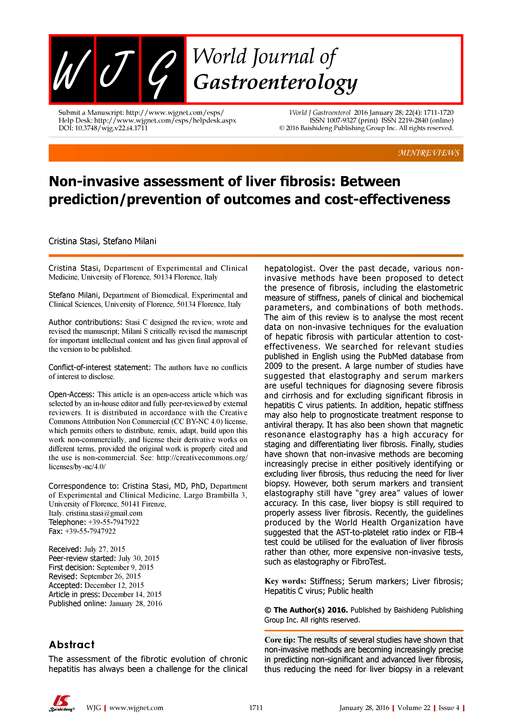Non-invasive assessment of liver fibrosis: Between prediction/prevention of outcomes and cost-effectiveness.
World journal of gastroenterology : WJG
Stasi C, Milani S
2016 World J. Gastroenterol. Volume 22 Issue 4
PubMed 26819535 DOI 10.3748/wjg.v22.i4.1711
The assessment of the fibrotic evolution of chronic hepatitis has always been a challenge for the clinical hepatologist. Over the past decade, various non-invasive methods have been proposed to detect the presence of fibrosis, including the elastometric measure of stiffness, panels of clinical and biochemical parameters, and combinations of both methods. The aim of this review is to analyse the most recent data on non-invasive techniques for the evaluation of hepatic fibrosis with particular attention to cost-effectiveness. We searched for relevant studies published in English using the PubMed database from 2009 to the present. A large number of studies have suggested that elastography and serum markers are useful techniques for diagnosing severe fibrosis and cirrhosis and for excluding significant fibrosis in hepatitis C virus patients. In addition, hepatic stiffness may also help to prognosticate treatment response to antiviral therapy. It has also been shown that magnetic resonance elastography has a high accuracy for staging and differentiating liver fibrosis. Finally, studies have shown that non-invasive methods are becoming increasingly precise in either positively identifying or excluding liver fibrosis, thus reducing the need for liver biopsy. However, both serum markers and transient elastography still have "grey area" values of lower accuracy. In this case, liver biopsy is still required to properly assess liver fibrosis. Recently, the guidelines produced by the World Health Organization have suggested that the AST-to-platelet ratio index or FIB-4 test could be utilised for the evaluation of liver fibrosis rather than other, more expensive non-invasive tests, such as elastography or FibroTest.
Citation Reference:

